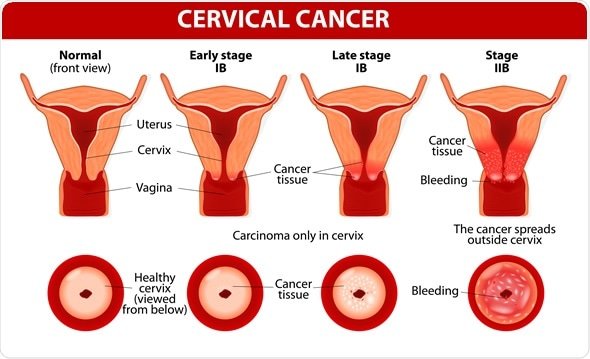Cancer is a group of disease that involve abnormal cell growth with the potential to invade or spread to other parts of the body.
Cancer is normally suspected through a new lump (growth) abnormal bleeding, a prolonged cough, unexplained weight loss and a change in bowel movement among others.
There are over 100 different known cancers that affect humans. Between 2006 and 2009, the cancer registry at the Ocean Road Cancer Institute (ORCI), the only cancer institute in Tanzania, showed three most common cancers affecting Tanzanians to be cervical cancer (Shingo ya kizazi) 35 percent; (Kaposi sarcoma muscles 12 percent and breast cancer 8 percent.
According to the Tanzania Non-Communicable Diseases Alliance (TANCDA), cervical cancer was caused by a virus called human papillomavirus (HPV). This virus infected a person through sexual intercourse.
When present, common symptoms of cervical cancer may include vaginal bleeding: This includes bleeding between periods, after sexual intercourse or post-menopausal bleeding; unusual vaginal discharge: A watery, pink or foul-smelling discharge is common. Pelvic pain or pain during intercourse or at other times may be a sign of abnormal changes to the cervix or less serious conditions.
The risky habits that could lead to a woman to suffer from cervical cancer include having sex at an earlier age (under 18 years). Becoming sexually active at an early age could be detrimental to a woman’s health because the uterus is not yet fully developed, making it more susceptible to viruses and other diseases.
Tobacco use is also a cause. Smoking is not only the leading cause of lung cancer, but it also plays an influential role in the appearance of other types of tumors. Women who smoke daily risk developing cancer of the cervix four times higher than those not exposed to tobacco.
This is due to the noxious substances in the tobacco that accelerate the growth of cells that become cancerous.
To have more than one partner or to have sexual intercourse with a person who has more partners is also a common case.
Excessive use of cooking oil in foods, especially animal oil; lack of eating enough vegetables and fruits regularly; and giving birth to many children, especially for women who delivered at an early age, such as below 18years.
Speaking in a past event Founder and President of the Medical Women Association of Tanzania, Professor Esther Mwaikambo, noted that Tanzania was fourth in the world in having the highest number of cervical cancer patients.
She said that the emergence of HIV in Tanzania has increased the prevalence of cervical cancer and Kaposi sarcoma. It is interesting to note that over 70 percent of cancer victims contract their disease before reaching the age of 60.
The greatest risk, therefore, of contracting cancer was between 30 and 50 years, which was the most productive age, studies have shown that more females 76 percent than males 24 percent were affected by cancer (ratio of 3:1).
She further said that for example, data from the ORCI have indicated that the Tanzania government was spending more than USD 40 million per year on managing cancers related to tobacco. Tobacco use was the cause of about 22 percent of all cancer death. Worse still, Tanzania is number one producer of tobacco in the East African sub-region.
Obesity, poor diet, lack of Physical activity, consumption of Alcohol were responsible for about 10 percent of all cancer death other factors that caused cancer include certain infection, exposure to ionizing radiation, and environmental pollutants.
In the developing world, including Tanzania, almost 20 percent of all cancer cases were due to infections such as hepatitis B, hepatitis C, and human papillomavirus (HPV). The recent rise in the occurrence of cancers in Tanzania called for urgent action.
Prof Mwaikambo suggested that modifiable and non-modifiable factors were among the main risk factors that needed to be targeted for effective prevention and control.
“Many cancers can be prevented by not smoking, by maintaining a healthy diet and weight, by not drinking too much alcohol, eating healthy foods, including vegetables, fruits, and whole grains.”
“Others are a vaccination against certain infectious diseases, not eating too much red meat, and not avoiding too much exposure to sunlight (albinos). Early detection through screening for cervical, colon and rectal cancers could be highly useful.”
However, Professor Mwaikambo retaliated that despite that knowledge, studies in Tanzania have indicated that screening for cervical cancer to be grossly inadequate at all levels of healthcare delivery.
Treatment facilities for pre-cancerous lesions in many districts, regional and referral hospitals were inadequate or non-existent despite some being simple, cheap and effective.
Population awareness on the importance of early screening was still low. There were social and cultural barriers discouraging patients to seek early treatment. Tanzania has no clear policy or guideline or cervical cancer screening and management.
The country has no clear policy or guidelines on cervical cancer screening and management. These drawbacks should be rectified for an effective preventive/control strategy.
“Every year on February 4, we recognize World cancer day to highlight the on-going fight against cancer. The day aims at reducing the number of preventable deaths each year by raising cancer awareness among the general public and pressing the government to take further action to strengthen cancer prevention, control, and treatment.”
Cancer was one of the leading causes of death in Sub-Saharan Africa, with cervical cancer, which was almost entirely preventable, ranked as the leading cause of cancer and cancer death for African women. East Africa has the highest cervical cancer incidences and mortality rates in the world.
Incidences of cervical cancer in the region was 42.7 per 100,000 women and mortality rates in East African countries range as high as 54 deaths per 100,000 women in Tanzania and 76 per 100,000 in Malawi.
There she managed a cervical cancer initiative that focused on raising community awareness increasing campaigns. The campaigns reached more than ten thousand women across three regions in Tanzania women observes; “Screening is not part of the routine and has not been integrated into primary care.
While Tanzania has made great strides in recent years by training health professionals in the simple techniques to screen and treat cervical pre-cancer and provide screening through mass campaigns, most women at risk have not yet been tested.
And as the country looks to increase access to screening services, they can encounter other challenges. As Dr. Damian states; “then there is the issue of training providers, the capacity of the facilities to conduct services”.

















Comments